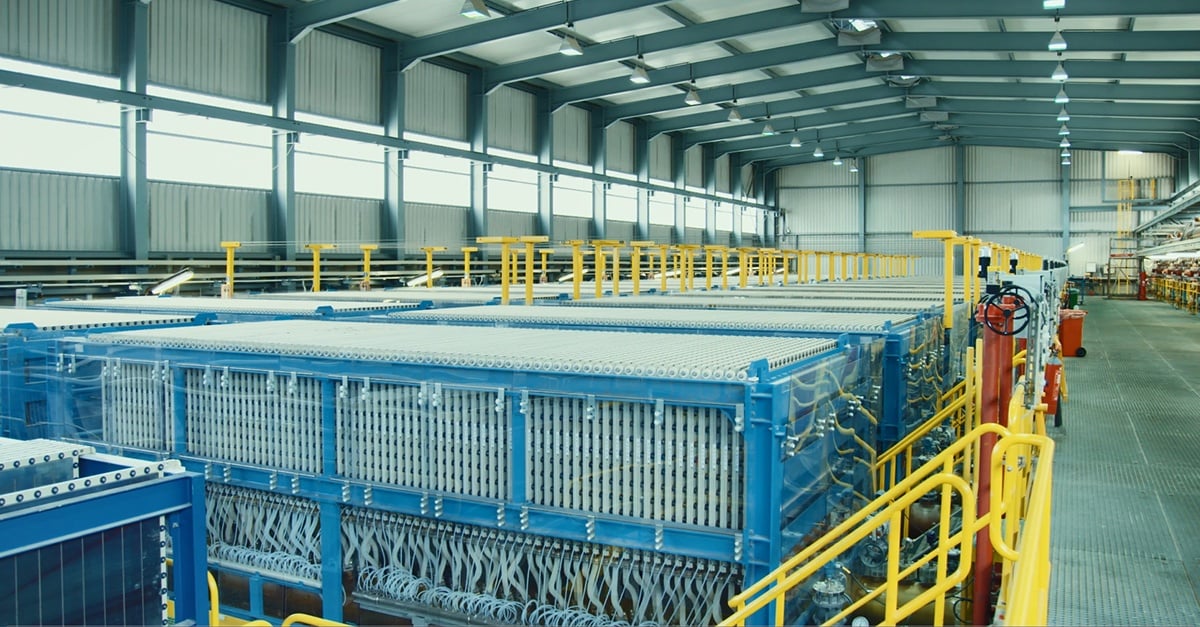The development of electrolysis as an industrial technology was a breakthrough for the commercial manufacturing of chemicals. Using this process to produce chlorine and caustic soda (NaOH, also called sodium hydroxide) or caustic potash (KOH, also known as potassium hydroxide) began late in the 19th century. Early technology involved the use of mercury cells, while newer membrane cell technology was developed in the 1960s.
Mercury cells have coated titanium anodes and liquid mercury cathodes. They produce chlorine at the anode and a sodium-mercury amalgam or potassium mercury amalgam at the cathode, which flows from the cell into a decomposer. In the decomposer, sodium is released to form sodium hydroxide and hydrogen is also formed. The recovered mercury is reused in the mercury cell. The advantage of mercury cell technology is the purity of sodium/potassium hydroxide, which is formed at a concentration of about 50%. However, the power usage is much higher than that of membrane cells.
In membrane cells, the anode and cathode are separated by a membrane, which allows sodium or potassium ions to pass through, but prevents the flow of chlorine or hydrogen ions. With membrane cell technology, there is no need for a decomposer because sodium hydroxide or potassium hydroxide forms directly at the cathode without the mercury amalgam step. The concentration of sodium or potassium hydroxide is typically around 30%. In a next step, this concentration is increased using evaporators. Membrane cells use about 26% less energy than mercury cells but a further step is required to concentrate the product.
By the time membrane cell technology became accessible as an industrial solution, there was already a significant precedent established for the use of mercury cell chlorine plants. As such, converting from mercury cells to membrane cells was an expensive capital undertaking. Although there is a return on investment through energy savings, this return is not usually sufficient to justify the capital expense on its own. The rate of return for such projects is typically about 20 years. Nevertheless, these projects are necessary and reflect responsible practice: conversion from mercury cells to membrane cells is primarily driven by occupational health and environmental concerns.
Vynova has demonstrated industry leadership through an aggressive capital investment program for conversion to membrane cells across all its facilities.
What’s wrong with mercury cell technology?
The World Health Organisation classifies mercury as one of the top ten chemicals posing a major public health concern. It is a naturally occurring element released into the environment by volcanic activity, weathering of rocks and human activity. Mercury is toxic to humans and especially affects foetuses and people regularly exposed through diet or occupation.
As awareness of mercury hazards has grown and focus on monitoring and controlling mercury emissions increases, the chemical industry has been moving away from mercury cell technology. In 2001, the European chlor-alkali sector formally committed to a gradual phase-out of mercury cell technology by 2020.
From 2001 to 2015, the number of mercury cell plants reduced from over 90 to fewer than 35. This equated to a two-thirds reduction in the production of chlorine using mercury cells. Over the same time period, the chlor-alkali industry reduced their mercury emissions by 80%.
Why was December 2017 so significant?
Initial voluntary commitments from the European chlor-alkali industry were to phase out mercury cells by 2020. However, in 2010, the European Parliament issued a directive called the Industrial Emissions Directive (IED). One of the principles of the IED is the idea of using Best Available Technology (BAT).
Due to environmental and health hazards, mercury cells are no longer considered a BAT. Therefore, when the BAT conclusions became legally binding under the IED in 2013, the fate of mercury cell plants was sealed. By 11 December 2017, all mercury cell operations in Europe were required to shut down.
Vynova’s state-of-the-art conversion
The history of mercury cell potassium electrolysis at our affiliated plant in Thann (France) stretches back to 1927, but an 18-month conversion project was initiated in 2013 – well before the compulsory deadline. The project was completed in 2015, on schedule and within an investment of €52 million. The Thann facility now produces all its chlorine and potassium hydroxide using new membrane cell process units.
The conversion project from mercury to membrane cell technology of the KOH production unit at our Tessenderlo site was initiated in 2015, within a month of ICIG’s acquisition of the site. Tessenderlo’s new membrane cell plant was successfully commissioned in April 2018 at a cost of about €65 million. Through these projects, we have demonstrated our total commitment to safe and environmentally conscious operations.
As a result of these investments, we have become the only KOH producer in Europe with two membrane cell production facilities. In fact, we are the largest KOH producer in the market with the largest installed capacity. Our investment in the best available technology ensures our ability to maintain a reliable supply of the highest quality product to our customers. KOH is the intermediate stream from which all our potassium derivatives are produced. Therefore, our entire potassium products and services range is built upon the foundation of the membrane cell facilities.
Vynova also operates a state-of-the-art membrane electrolysis facility for the production of caustic soda in Tessenderlo as well as in Runcorn, in a 50/50 joint venture with Inovyn.
Connect with Vynova
Vynova uses membrane cell technology to produce chlorine, caustic soda, potassium hydroxide and hydrogen. We have membrane cell plants at our Runcorn, Thann, and Tessenderlo facilities. Reach out to Vynova to enquire about reliable product supply for your needs. Find out more about Vynova here.




